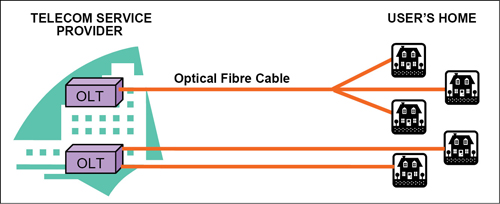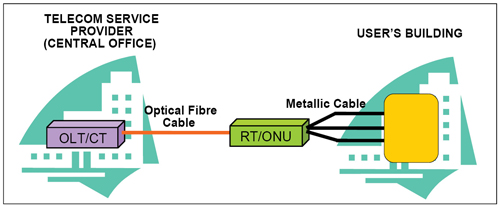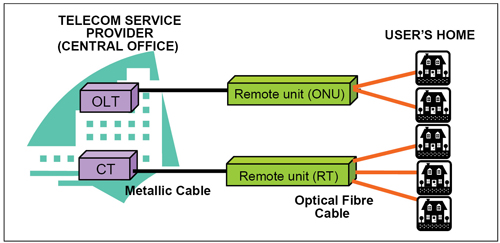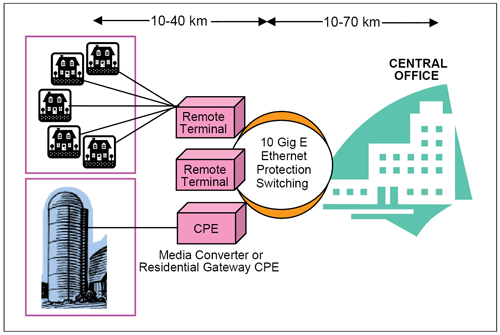Since long back, telecommunication service providers have dreamed of an all-fibre network and for good reasons. A fibre provides substantially more bandwidth, carries signals farther, is more reliable and secure, and has a longer life span. Additionally, providers view fibre’s bandwidth capacity as a competitive weapon, particularly in the access network.
Fibre is seen as the pre-eminent long-term alternative to today’s broadband access technologies. One that not only allows providers to generate new services but also provides them with significant and sustainable reductions in operating expenses, and shifts their capital spending from older technologies to newer, less costly technologies. The single greatest driver for fibre in the access network is multi-play services, the opportunity to offer subscribers high-speed data, voice and video as one of a variety of potential bundled services.

Fig. 1: FTTH configuration

Fig. 2: FTTB configuration
Today, fibre networks come in many varieties, and telecommunication service providers consider a variety of FTTx architectures (here ‘x’ stands for the termination point) for delivering fibre to their subscribers. Depending on the termination point, FTTx is classified as fibre-to-the-premise (FTTP), fibre-to-the-home (FTTH), fibre-to-the-building (FTTB), fibre-to-the-curb (FTTC) or fibre-to-the-node (FTTN), each having different configurations and characteristics.
Currently, there is no one-size-solves-all architecture, so providers must make a series of technology decisions based on their service goals. A primary consideration for providers is to decide whether to deploy an active (point-to-point) or passive (point-to-multipoint) fibre network.
Configurations
FTTx configurations depend on how the optical fibre is used in the last-mile access network.
FTTH. It is a method of installing optical fibre cable to the home. FTTH is the final configuration of access networks using optical fibre cable. It consists of a single optical fibre cable from the telecom service provider’s central office, or base station, to the subscriber’s home. An OLT optical line terminal (OLT) at central office connects optical network unit (ONU) residing at subscriber’s home through a dedicated fibre. The optical-to-electrical signal conversion is done through a modem and connection to the user’s computer is established via an Ethernet card (Fig. 1).
FTTB. In this configuration, optical fibre cable is run from the telecom service provider’s central office (OLT/central terminal) or base station to the building’s termination point (ONU/remote terminal). A local area network (LAN), or existing telephone metallic cable, is then used to connect the user (Fig. 2).
FTTC. It is a method of installing optical fibre cable by the curb near the user’s home. An optical communications system is then used for the remote (optical or electrical) signal conversion unit installed outside (near the curb or on a telephone pole) the installation centre. Finally, metallic telephone cable, coaxial cable or other similar cable is used between the remote unit and user (Fig. 3).
Architectures
Selection of network architecture to be implemented is a very important criterion for providing telecom services to the consumers. A telecom service provider considers aspects such as network location, the cost of deploying the network, subscriber density, existing outside plant, the return on investment (ROI) and many more things.

Fig. 3: FTTC configuration

Fig. 4: Active star Ethernet architecture
Basically, two types of architectures are available, namely, active and passive. Active architectures are sometimes referred to as home-run fibre and/or active star Ethernet. On the other hand, passive architectures, which include passive optical networks (PONs), are the current choices. Each has its own pros and cons, and the final selection depends on the provider’s unique requirements.
Active optical networks (AONs)
Home-run fibre (point-to-point). As the name suggests, active optical networks employ active or powered devices. A home-run fibre architecture is one in which a dedicated fibre from an optical line terminal (OLT) located in the central office of the telecom service provider connects in a point-to-point fashion to an optical network terminal (ONT) residing at subscriber’s premises. Both OLTs and ONTs are active, or powered, devices, and each is equipped with an optical laser. Subscribers can be located as far away from the central office of the service provider as 80km, and each subscriber is provided a dedicated fibre that provides full bi-directional communication.
Home-run fibre is the most flexible architecture over the long term. However, it may be less attractive when the physical layer costs are considered. Since a dedicated fibre is deployed to each premise, home-run fibre requires installation of lot more fibres than other options, with each fibre running the entire distance between the subscriber and the central office. The fibre cost and size of the fibre bundle at the OLT can make this network expensive and inconvenient in many service areas.








Gentlemen
Can you clarify the contents of OLT the electronic circuit and method of work of the department
Regards